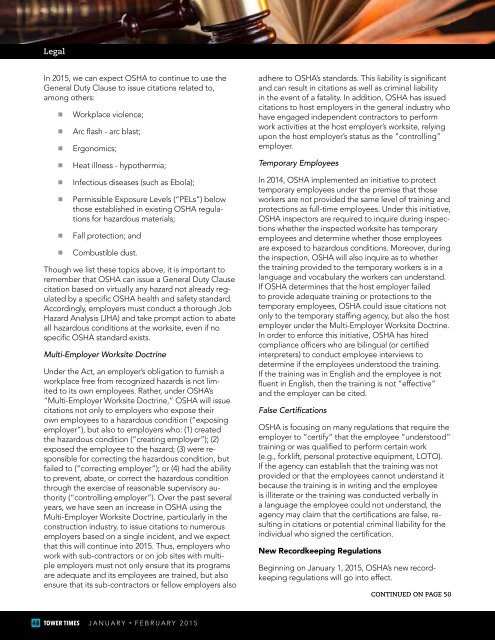Jan-Feb-2015-TT-for-Website
Jan-Feb-2015-TT-for-Website
Jan-Feb-2015-TT-for-Website
Create successful ePaper yourself
Turn your PDF publications into a flip-book with our unique Google optimized e-Paper software.
Legal<br />
In <strong>2015</strong>, we can expect OSHA to continue to use the<br />
General Duty Clause to issue citations related to,<br />
among others:<br />
■■<br />
■■<br />
■■<br />
■■<br />
■■<br />
■■<br />
■■<br />
■■<br />
Workplace violence;<br />
Arc flash - arc blast;<br />
Ergonomics;<br />
Heat illness - hypothermia;<br />
Infectious diseases (such as Ebola);<br />
Permissible Exposure Levels (“PELs”) below<br />
those established in existing OSHA regulations<br />
<strong>for</strong> hazardous materials;<br />
Fall protection; and<br />
Combustible dust.<br />
Though we list these topics above, it is important to<br />
remember that OSHA can issue a General Duty Clause<br />
citation based on virtually any hazard not already regulated<br />
by a specific OSHA health and safety standard.<br />
Accordingly, employers must conduct a thorough Job<br />
Hazard Analysis (JHA) and take prompt action to abate<br />
all hazardous conditions at the worksite, even if no<br />
specific OSHA standard exists.<br />
Multi-Employer Worksite Doctrine<br />
Under the Act, an employer’s obligation to furnish a<br />
workplace free from recognized hazards is not limited<br />
to its own employees. Rather, under OSHA’s<br />
“Multi-Employer Worksite Doctrine,” OSHA will issue<br />
citations not only to employers who expose their<br />
own employees to a hazardous condition (“exposing<br />
employer”), but also to employers who: (1) created<br />
the hazardous condition (“creating employer”); (2)<br />
exposed the employee to the hazard; (3) were responsible<br />
<strong>for</strong> correcting the hazardous condition, but<br />
failed to (“correcting employer”); or (4) had the ability<br />
to prevent, abate, or correct the hazardous condition<br />
through the exercise of reasonable supervisory authority<br />
(“controlling employer”). Over the past several<br />
years, we have seen an increase in OSHA using the<br />
Multi-Employer Worksite Doctrine, particularly in the<br />
construction industry, to issue citations to numerous<br />
employers based on a single incident, and we expect<br />
that this will continue into <strong>2015</strong>. Thus, employers who<br />
work with sub-contractors or on job sites with multiple<br />
employers must not only ensure that its programs<br />
are adequate and its employees are trained, but also<br />
ensure that its sub-contractors or fellow employers also<br />
adhere to OSHA’s standards. This liability is significant<br />
and can result in citations as well as criminal liability<br />
in the event of a fatality. In addition, OSHA has issued<br />
citations to host employers in the general industry who<br />
have engaged independent contractors to per<strong>for</strong>m<br />
work activities at the host employer’s worksite, relying<br />
upon the host employer’s status as the “controlling”<br />
employer.<br />
Temporary Employees<br />
In 2014, OSHA implemented an initiative to protect<br />
temporary employees under the premise that those<br />
workers are not provided the same level of training and<br />
protections as full-time employees. Under this initiative,<br />
OSHA inspectors are required to inquire during inspections<br />
whether the inspected worksite has temporary<br />
employees and determine whether those employees<br />
are exposed to hazardous conditions. Moreover, during<br />
the inspection, OSHA will also inquire as to whether<br />
the training provided to the temporary workers is in a<br />
language and vocabulary the workers can understand.<br />
If OSHA determines that the host employer failed<br />
to provide adequate training or protections to the<br />
temporary employees, OSHA could issue citations not<br />
only to the temporary staffing agency, but also the host<br />
employer under the Multi-Employer Worksite Doctrine.<br />
In order to en<strong>for</strong>ce this initiative, OSHA has hired<br />
compliance officers who are bilingual (or certified<br />
interpreters) to conduct employee interviews to<br />
determine if the employees understood the training.<br />
If the training was in English and the employee is not<br />
fluent in English, then the training is not “effective”<br />
and the employer can be cited.<br />
False Certifications<br />
OSHA is focusing on many regulations that require the<br />
employer to “certify” that the employee “understood”<br />
training or was qualified to per<strong>for</strong>m certain work<br />
(e.g., <strong>for</strong>klift, personal protective equipment, LOTO).<br />
If the agency can establish that the training was not<br />
provided or that the employees cannot understand it<br />
because the training is in writing and the employee<br />
is illiterate or the training was conducted verbally in<br />
a language the employee could not understand, the<br />
agency may claim that the certifications are false, resulting<br />
in citations or potential criminal liability <strong>for</strong> the<br />
individual who signed the certification.<br />
New Recordkeeping Regulations<br />
Beginning on <strong>Jan</strong>uary 1, <strong>2015</strong>, OSHA’s new recordkeeping<br />
regulations will go into effect.<br />
CONTINUED ON PAGE 50<br />
48 TOWER TIMES JANUARY ■ FEBRUARY <strong>2015</strong>







